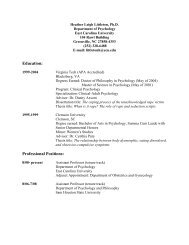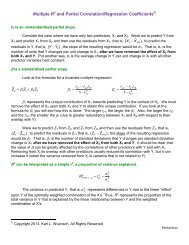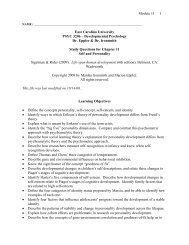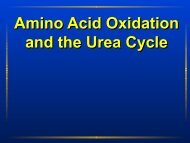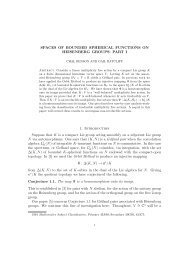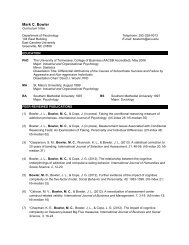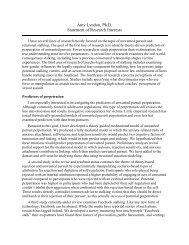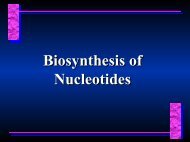Defining and Measuring Trophic Role Similarity in Food Webs Using ...
Defining and Measuring Trophic Role Similarity in Food Webs Using ...
Defining and Measuring Trophic Role Similarity in Food Webs Using ...
Create successful ePaper yourself
Turn your PDF publications into a flip-book with our unique Google optimized e-Paper software.
316J. J. LUCZKOVICH ET AL.equivalence, based on euclidean distances <strong>and</strong>correlations, as well alternative algorithms, arewell known <strong>in</strong> the social sciences <strong>and</strong> areavailable <strong>in</strong> st<strong>and</strong>ard software packages. Structuralequivalence is ideally suited for certa<strong>in</strong>analytical tasks. Structurally equivalent speciesare literally are structurally <strong>in</strong>dist<strong>in</strong>guishable,tied to the same others <strong>in</strong> the same ways.Consequently, for all structural ecologicalprocesses F by which we mean processes whoseoutcomes are pr<strong>in</strong>cipally determ<strong>in</strong>ed by thestructure of the trophic network F we canexpect structurally equivalent species to havesimilar outcomes, or common fate (Homans,1950). Thus, <strong>in</strong> trophic impact studies, anyth<strong>in</strong>gthat happens to a species of predator or prey isexpected to happen to all other species <strong>in</strong> thesame structural equivalence class, because theyhave exactly the same prey or predators. In thisrespect, structural equivalence may have anadvantage over maximal regular equivalence, asit is unclear if or under what conditions thecommon fate hypothesis can be applied toregular equivalence classes.The disadvantage of structural equivalence isthat it cannot recognize the structural similarityof species that share no predators or prey.Consequently, species <strong>in</strong> clearly analogous positions,which are functionally equivalent, are seenas completely dissimilar. For example, <strong>in</strong> theMalaysian <strong>in</strong>sect food web, food sources that aresimilar (organic debris <strong>and</strong> recently drowned<strong>in</strong>sects) were not regarded as similar by thestructural method of Yodzis & W<strong>in</strong>emiller(1999), yet they clearly are similar <strong>in</strong> that theyconsume noth<strong>in</strong>g <strong>and</strong> are eaten by similarspecies. Regular equivalence solves this problemof not detect<strong>in</strong>g similarity <strong>in</strong> trophic role whenspecies share no or very few prey or predators.Regular equivalence can be used to f<strong>in</strong>dspecies play<strong>in</strong>g similar roles <strong>in</strong> spatially <strong>and</strong>temporally separate food webs <strong>in</strong> which speciesdo not consume the exact same prey, possiblyopen<strong>in</strong>g the door for new k<strong>in</strong>ds of comparativeresearch. For example, <strong>in</strong> Jackson et al. (2001),the authors proposed that humans have alteredcoastal ecosystems by fish<strong>in</strong>g <strong>and</strong> hunt<strong>in</strong>gactivities that have caused long-last<strong>in</strong>g foodweb changes. In the Pacific kelp forest foodweb, when sea otters were extirpated, there was adecades-long lag response <strong>in</strong> the overgraz<strong>in</strong>geffect of sea urch<strong>in</strong>s, their primary prey. The lagwas due to the fact that other unexploited speciessuch as abalones <strong>and</strong> sp<strong>in</strong>y lobsters ‘‘y ofa similar trophic level assumed the ecologicalroles of overfished speciesy (emphasis ours)(p. 629)’’. Our regular equivalence analysiswould allow a quantitative assessment of thesimilarity of these species’ trophic roles, evenwhen they did not prey on the same species <strong>and</strong>were preyed upon by different species. Thus, wecan create a simple model of trophically redundantrelationships when they occur <strong>in</strong> thesame food web at different po<strong>in</strong>ts <strong>in</strong> time, oreven <strong>in</strong> spatially separate food webs. Whilestructural equivalence may also be used <strong>in</strong> suchan example, it would be better for study<strong>in</strong>gdirect trophic impacts <strong>and</strong> model<strong>in</strong>g directcompetition between species, whereas regularequivalence could be used to model the potentialfor species to overlap <strong>in</strong> trophic role, shouldtheir feed<strong>in</strong>g habits shift as suggested by Jacksonet al. (2001).The approach we have outl<strong>in</strong>ed has someadditional benefits <strong>in</strong> quantify<strong>in</strong>g trophic roles<strong>and</strong> display<strong>in</strong>g reduced complexity food webs.Like the approach of Yodzis & W<strong>in</strong>emiller(1999), we have proposed a method that willf<strong>in</strong>d similarity among species based on theirrelationships with predators <strong>and</strong> prey. This thenforms a new basis for aggregat<strong>in</strong>g species.The problemof how to aggregate nodes <strong>in</strong> anetwork of <strong>in</strong>teractions so as to elim<strong>in</strong>ate detailwhile reta<strong>in</strong><strong>in</strong>g structure is universal <strong>in</strong> systemmodel<strong>in</strong>g. In fact, this issue has been formallyapproached previously <strong>in</strong> ecological networkanalysis. A method for network aggregationwas proposed by Hirata & Ulanowicz (1985), <strong>in</strong>which a 17-compartment carbon-flow networkof a tidal marsh creek was aggregated <strong>in</strong>to aseven-compartment system by m<strong>in</strong>imiz<strong>in</strong>g theloss of mutual <strong>in</strong>formation that occurred dur<strong>in</strong>ga sequence of aggregation steps. Their graph ofthe seven-compartment ecosystem flow diagramwas essentially an image graph, but the aggregationswere based on m<strong>in</strong>imiz<strong>in</strong>g the decrease<strong>in</strong> network mutual <strong>in</strong>formation, an empiricalstatistic they computed, which is based onnetwork redundancy measures. Although thegeneral approach is similar to ours, Hirata &



